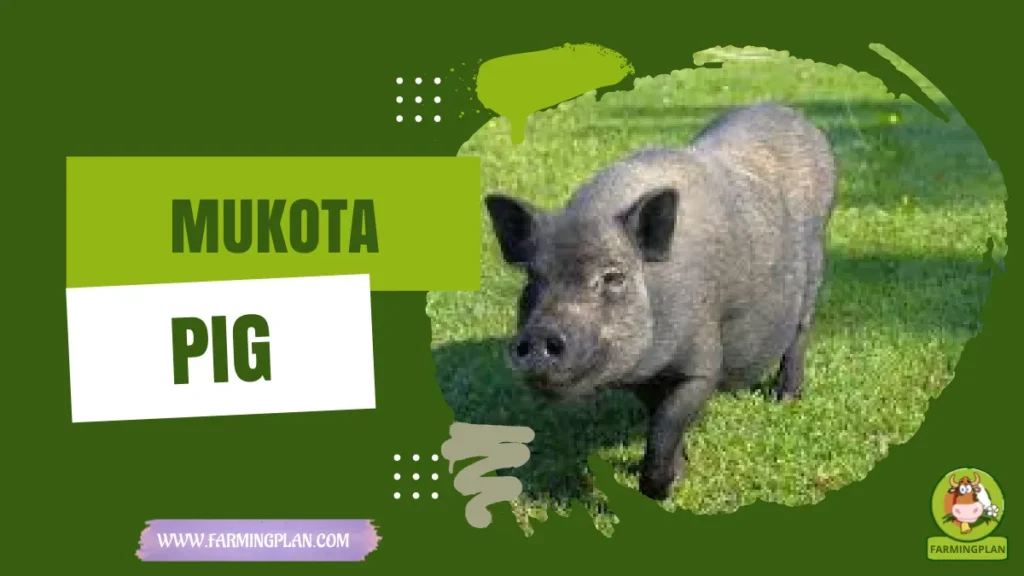Let me tell you about one of my favorite rabbits to raise—the Alaska Rabbit. This medium-sized, jet-black beauty is known for its soft, glossy coat and calm, friendly nature. Despite the name, it didn’t come from Alaska, but it sure thrives in cooler climates. As a longtime breeder, I’ve found Alaska Rabbits to be one of the sweetest and most striking breeds out there. They’re perfect for families, pet lovers, and breeders alike. In this guide, I’ll cover everything you need to know—from their origins and personality to care, feeding, and health tips—so you can decide if this elegant bunny is right for your home or farm.
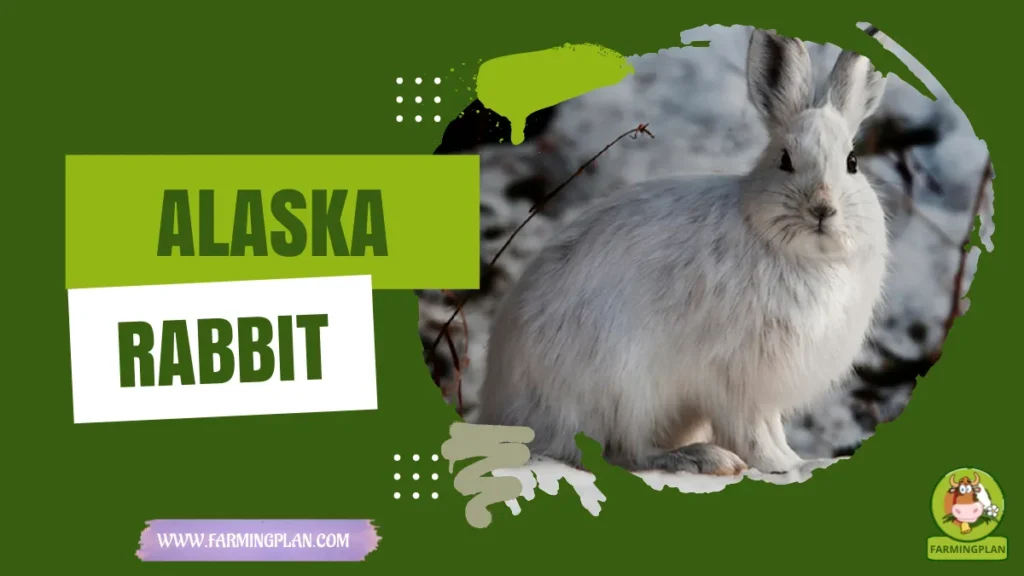
History & Origin of Alaska Rabbit
The Alaska Rabbit may have “Alaska” in its name, but don’t let that fool you. These bunnies were actually developed in Germany in the early 1900s. Breeders were originally trying to create a rabbit that looked like the prized Arctic fox, mainly for its luxurious fur. The goal was to produce a beautiful black-furred animal that was strong and adaptable.
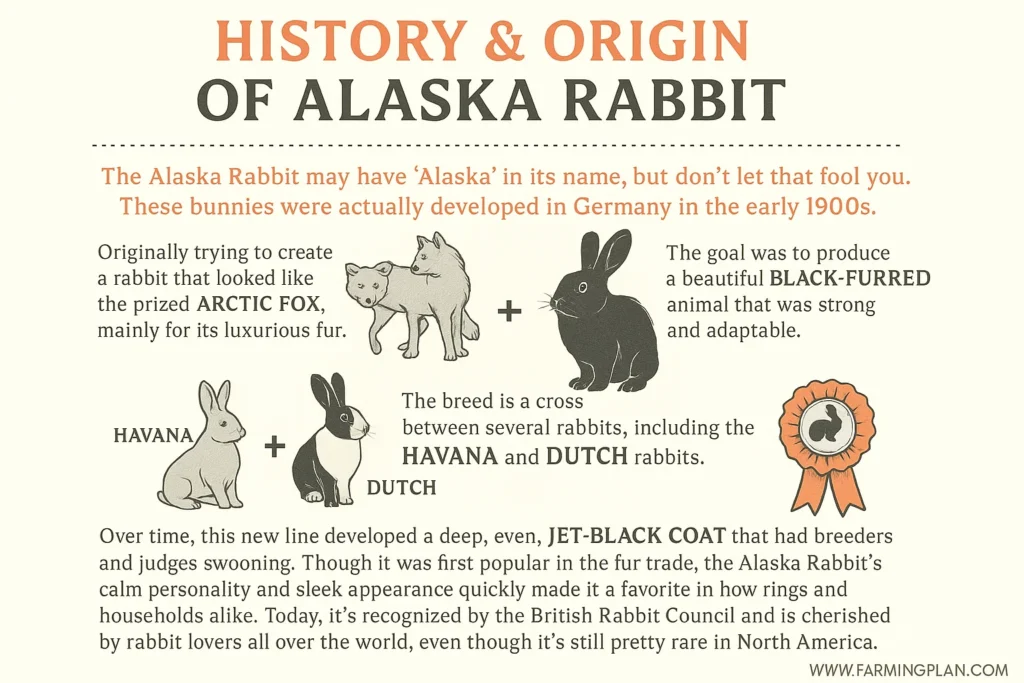
The breed is a cross between several rabbits, including the Havana and Dutch rabbits. Over time, this new line developed a deep, even, jet-black coat that had breeders and judges swooning. Though it was first popular in the fur trade, the Alaska Rabbit’s calm personality and sleek appearance quickly made it a favorite in show rings and households alike. Today, it’s recognized by the British Rabbit Council and is cherished by rabbit lovers all over the world, even though it’s still pretty rare in North America. It’s a perfect mix of beauty and docility—and that’s why I fell in love with the breed.
Read More: Argente Clair Rabbit: Complete Farming Guide
Characteristics of Alaska Rabbit
The Alaska Rabbit is medium-sized and compact, usually weighing around 7 to 9 pounds. It has a barrel-shaped body with strong, muscular legs, making it both sturdy and huggable. But what really stands out is the coat—a deep, jet-black fur that feels like velvet and shines beautifully in the light.
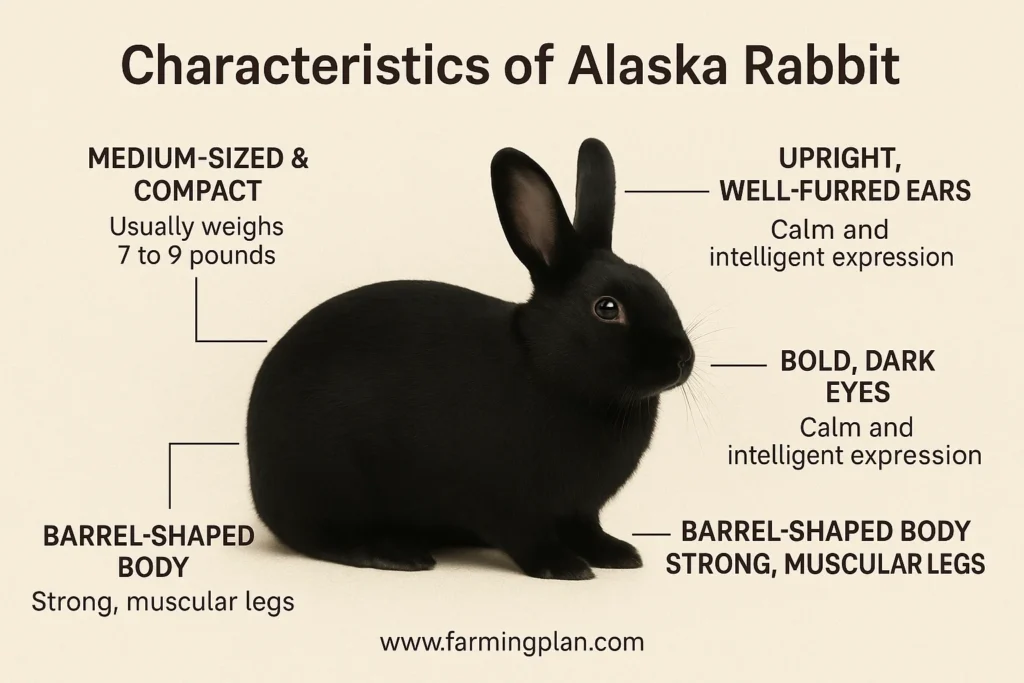
The coat is dense, smooth, and even from head to tail. Unlike other black rabbits, the Alaska’s fur has no brown or blue tints. It’s as if it was dipped in ink. This rabbit’s ears are upright and well-furred, and its eyes are bold and dark, giving it a calm and intelligent expression. They don’t come in different colors; the standard is one striking color: black. And trust me, when you see a group of these bunnies together, they look like shadows dancing in the grass. It’s no wonder they’re so popular in rabbit shows.
Read More: Argente Blue Rabbit: Secret Successful Farm
Nature & Temperament of Alaska Rabbit
If you’re looking for a good-tempered and docile animal, the Alaska Rabbit is one of the calmest rabbit breeds around. These bunnies are social animals that enjoy interaction with humans and fellow rabbits. They bond easily and make fantastic companions for both kids and adults.
They respond well to soft voices and gentle handling, making them ideal for first-time rabbit owners or families with kids. I often recommend them to folks who want a calm bunny that isn’t skittish or overly energetic. Just give them a little love and a safe environment, and they’ll flourish. Keep in mind, they are classic prey animals, so sudden movements or loud noises can startle them. But with a clean litter box, consistent care, and daily social time, they quickly become part of the family.
Velvet‑Black Bunny Bliss Brings Calm, Companionship, And Joy To Every Family.
Food & Diet of Alaska Rabbit
A balanced diet is key to keeping your Alaska Rabbit healthy. I always start with high-quality hay—this should make up 70-80% of their diet. Timothy hay, orchard grass, or meadow hay are great options. It helps with digestion and keeps their teeth from overgrowing.
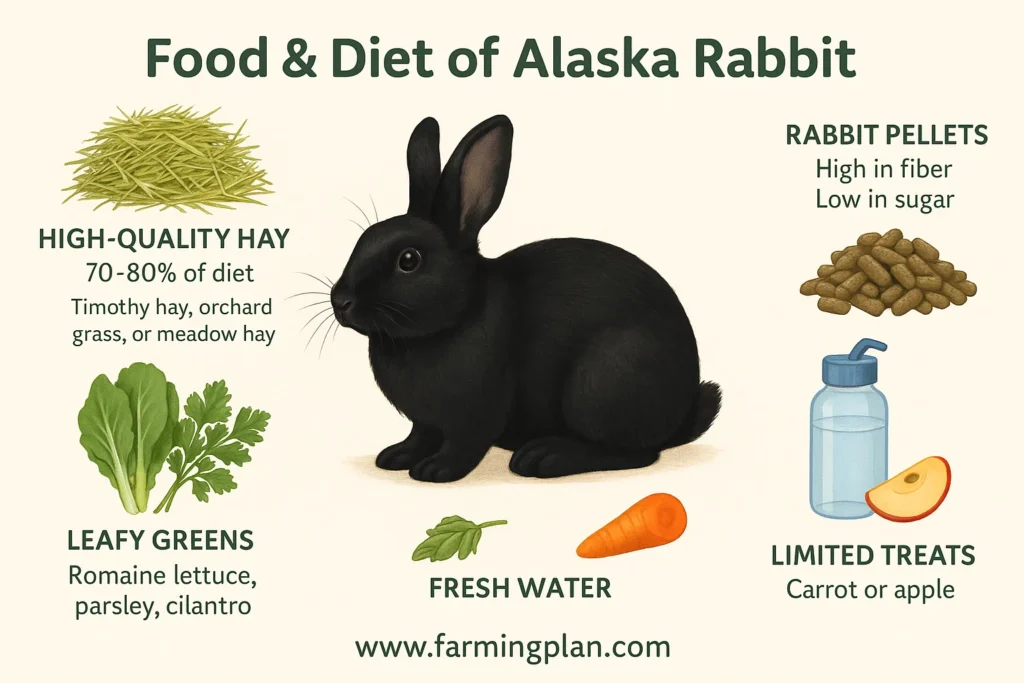
Pair the hay with a daily serving of rabbit pellets. Look for pellets that are high in fiber and low in sugar. You can also add leafy greens like romaine lettuce, parsley, and cilantro. But avoid iceberg lettuce and foods high in calcium like spinach. Fresh water is a must. I use a water bottle for convenience, but a clean bowl works too. Also, keep treats to a minimum. A small slice of carrot or apple is fine now and then, but too many sugary snacks can cause dental issues and obesity.
Read More: Gotland Rabbit: Swedish Variety of Bunny
Usage & Purpose
Alaska Rabbits were once popular in the fur trade thanks to their dense, beautiful coats. But today, they’re mainly raised as companion animals and show rabbits. Their calm nature and striking looks make them ideal for families, hobby breeders, and rabbit enthusiasts alike.
In rabbit shows, their even coloring and compact build give them an edge. Judges love the consistent jet-black coat. I’ve taken a few of mine to competitions, and they always draw attention. They’re also great educational animals. I’ve used them during school visits to teach kids about rabbits, care routines, and animal respect. They’re relaxed, cuddly, and photogenic—a real crowd-pleaser!
Special Features
One of the most unique things about the Alaska Rabbit is its fur. Unlike most black rabbit breeds, this one has a consistent, glossy, jet-black coat without any shading or undertones. It almost glows in the sunlight.
They also have a calm and easygoing temperament, which makes them perfect for households with kids, other pets, or beginner rabbit owners. Their thick coat gives them an edge in colder climates, too. Another bonus? Alaska Rabbits are generally clean animals. They can be litter-trained quite easily and love having a routine. When you combine their good looks, easy maintenance, and sweet personality, you get one of the most underrated rabbit breeds around.
Health Issues & Prevention
Like most rabbit breeds, the Alaska Rabbit is prone to a few health issues. Dental problems, like overgrown teeth, are common if they don’t eat enough hay. That’s why a hay-rich diet is non-negotiable.
They’re also susceptible to Rabbit Hemorrhagic Disease (RHD), so make sure to talk to your vet about vaccinations. Parasites and ear mites can pop up too, especially if your bunny is outdoors often. Always check their ears, teeth, and nails regularly. Keep their litter box clean, and don’t forget annual vet checkups. A safe space, fresh water, and a clean environment go a long way in preventing most issues.
Step-by-Step Pet Owner Care Guide
Step 1: Choose the Right Living Space
Set up a clean, spacious cage or enclosure with solid flooring. Wire-bottom cages can hurt their feet. Add bedding like aspen shavings or paper-based litter—never use pine or cedar. Provide hiding spots and chew toys to keep them busy.
Step 2: Keep a Consistent Feeding Routine
Start each day with fresh hay and clean water. Feed pellets and greens in measured amounts to avoid obesity. Treats can be given sparingly. Always check their food and water bowls every day.
Step 3: Social Time and Handling
Spend time with your rabbit daily. Talk softly, pet gently, and never pick them up suddenly. Let them hop around in a safe, enclosed area to stretch those strong little legs.
Step 4: Grooming & Coat Care
Brush weekly to remove loose fur and prevent matting. Check for parasites during grooming. Their dense coat doesn’t require trimming, but regular checks help spot issues early.
Step 5: Monitor Health & Vet Visits
Watch for signs of illness like runny eyes, lack of appetite, or unusual behavior. Schedule yearly vet checkups. Vaccinate against common diseases and trim nails every few weeks.
Expert Tips & Best Practices
- Use a soft voice and gentle hands; Alaska Rabbits respond best to calm energy.
- Keep the environment quiet and stress-free. Loud noises can scare them.
- Always provide unlimited hay—it keeps their teeth and gut healthy.
- Clean the litter box every 2–3 days to prevent smells and illness.
- Never bathe your rabbit. Spot clean with a damp cloth if needed.
Tip: If You Want A Happy Bunny, Think Like One—Routine, Safety, And Snacks Rule Their World!
FAQ
Are Alaska Rabbits good pets for beginners?
Yes! Their calm nature and ease of care make them perfect for first-time rabbit owners.
How long do Alaska Rabbits live?
They typically live 7 to 10 years with proper care and diet.
Can Alaska Rabbits be litter trained?
Absolutely. They’re naturally clean animals and can be trained to use a litter box.
What’s the difference between an Alaska Rabbit and Alaska Hare?
The Alaska Rabbit is a domestic breed, while the Alaska Hare is a wild species with a different body shape and behavior.
Where can I buy an Alaska Rabbit?
Look for reputable breeders or rabbit rescues. Always check for healthy conditions and responsible breeding practices.
Conclusion
The Alaska Rabbit is a beautiful, gentle, and easy-to-care-for pet that fits right into a calm, loving household. With its jet-black coat, sweet temperament, and low-maintenance needs, it’s a top pick for new pet owners and seasoned breeders alike. These rabbits thrive on routine, good food, and soft-spoken care—and in return, they offer quiet companionship and lots of cuddles. If you’re thinking of adding a rabbit to your family or breeding program, I highly recommend giving this breed a look. Ready to meet your new bunny buddy? Let the Alaska Rabbit hop right into your heart!

